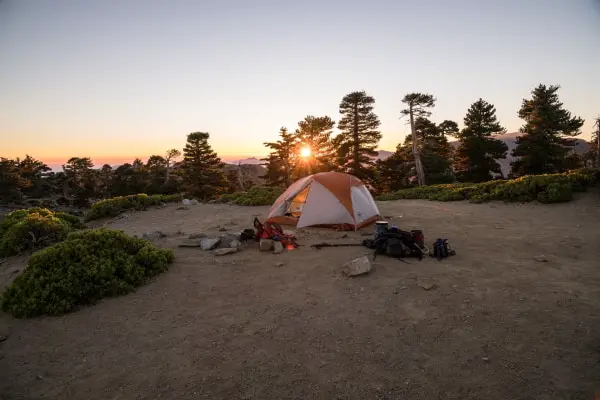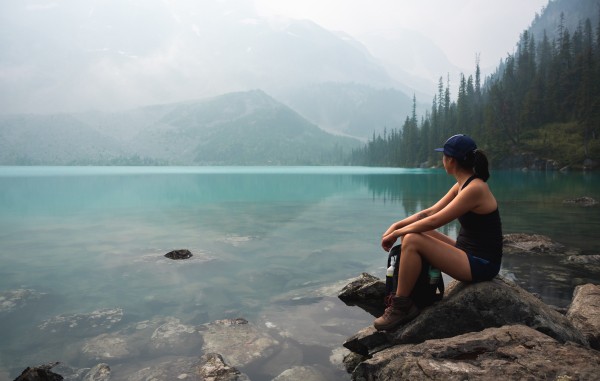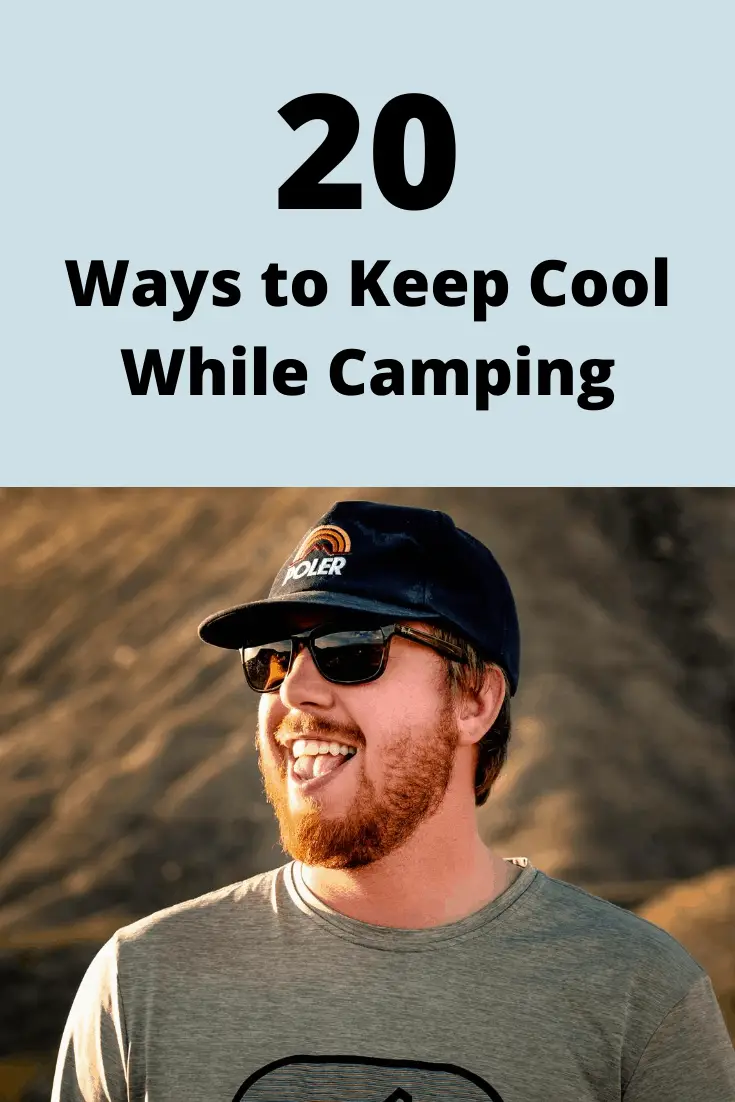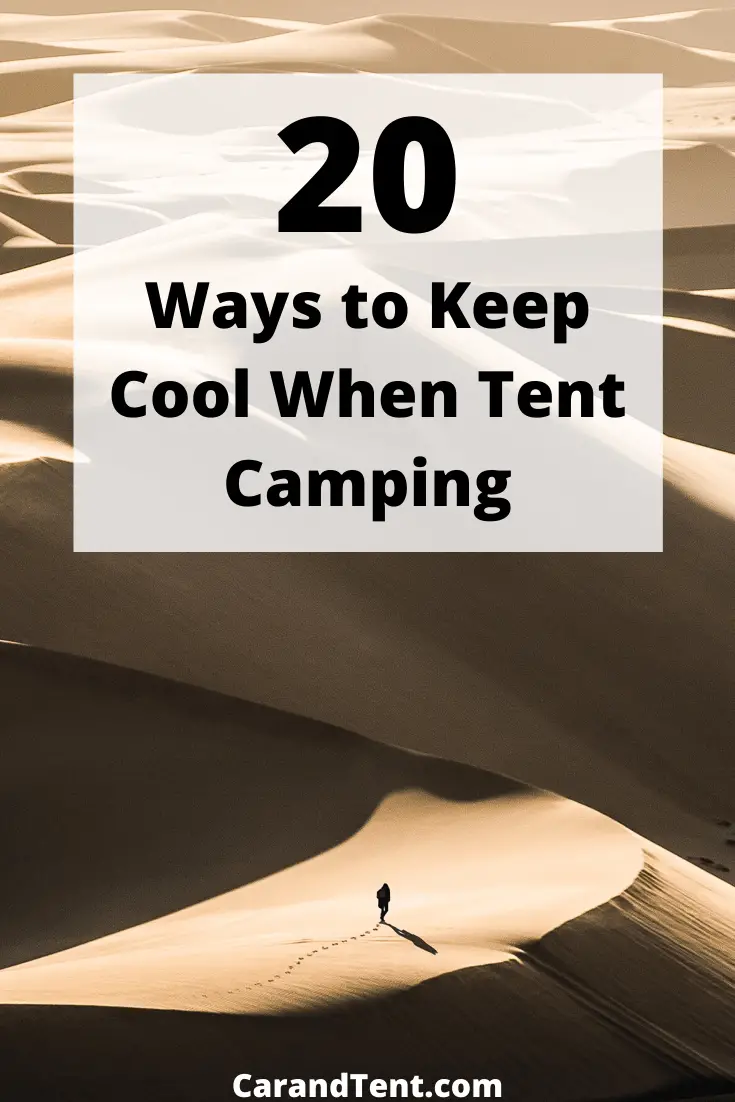
The most popular month for tent camping is June with July being a close second. These are great months for family camping because the kids and teachers are out of school and July usually includes a three-day weekend.
The only issue is that these months are hot.
So how do you go tent camping when it’s hot? How do you keep cool at your campsite and inside your tent?
Here are my top tips for staying cool while tent camping in the heat.
Table of Contents
Get a Campsite with Electricity
Camping doesn’t have to be rustic. Get a campsite with electricity or bring your own generator. This way, you’ll be able to bring some large fans.
Bring a tall tent and place a large oscillating fan or box fan inside of it. This will push your body heat away from you and it will help your body with evaporative cooling.
I’ve even seen people bring their own ice makers and mini-fridges to modern tent camping sites. They used them for cold drinks and to make ice packs to cool themselves down with.
In extreme cases, you may even be able to bring your own portable air conditioner with you.
Here is a video of someone who does just that.
If you do decide to bring your own AC unit, just be sure you have the ability to set it up properly. Also, keep in mind that some campgrounds will have quiet hours and you won’t be able to run your generator during those hours. These hours are at night so if you’re planning on running a generator so that you can run your air conditioner while you sleep, you may be out of luck.
Best to call ahead so that you know what the rules are before you drag a generator and air conditioner out to the campsite with you.
Choose a Campsite Near Water
It’s always a little cooler near water sources like oceans, rivers, and even lakes. The reason for this is because of lake breezes.
According to the National Weather Service, these cool breezes form when the land becomes warmer than the water. The warm air then rises and gets replaced by the cool air that resides over the lake’s surface. This, in turn, causes a breeze to form which pushes this air to shore.
In short, camp near water and you’ll be cooler than if you didn’t.
Pick a Campsite at High Altitude
An increase in altitude will also bring a decrease in temperatures. The reason for this is because pressures are lower at higher altitudes and the more pressure, the more air heats up.
Sometimes this decrease in temperature can be quite dramatic. This is because for every 1,000 feet in altitude, the temperature drops by 3.6 degrees Fahrenheit.
Here is a quick chart so you can see what this would mean for you. It is based on a day when it’s 85 degrees at sea level.
| Altitude | The Temperature in Degrees Fahrenheit |
| Sea Level | 85 Degrees |
| 1,000 ft | 81.4 |
| 2,000 ft | 77.8 |
| 3,000 ft | 74.2 |
| 4,000 ft | 70.6 |
| 5,000 ft | 67 |
For a graphical view of what altitude changes might do to the temperature, take a look at my post on hiking up a mountain.
While all of these altitudes might seem laughable to someone living in Delaware, they are quite achievable in many nearby states.
In fact, if you just head north to New York, you’ll find elevations as high as 5,344 feet. Even neighboring Pennsylvania can bring you as high as 3,213 feet.
Find a Campsite in the Woods
Trees help to keep temperatures cooler in the summer and warmer in the winter. This is because they provide an insulating effect.
On top of this, they create shade which also helps to keep you cool while you’re up and about.
Lastly, they provide something known as evapotranspiration. This is when the water that plants soak up through their roots, evaporates on their surface. When this occurs, the area around these plants becomes cooler.
More than 99.9% of the water that these plants consume ends up evaporating into the air, so the effect can be quite significant when you’re in a forest full of trees. If you find this phenomenon as fascinating as I do, you can get a quick overview of it from Colorado State University.
Create Your Own Shade
If you can’t find shade, make your own. Desert campers don’t have the luxury of moving into the forest and they can’t hang tarps on trees to create extra shade.
As a result, a person camping in the desert has to bring their own canopy. In places like Death Valley, you might not survive without them.
According to the National Park Service, Death Valley can reach temperatures of 120 degrees. You can’t lower the temperature, but you can make it feel 10 to 15 degrees cooler by avoiding the solar radiation that the sun brings to the table.
Get a Mesh Tent
Even a rainfly can trap body heat. Avoid this by getting a mesh tent that will protect you from bugs and insects while allowing heat to escape.
If it rains and you have to put the fly back on, make sure you do it properly. Elevate the rain fly off of the tent’s base so that air can flow out of the tent.
This will keep you cooler and will help to reduce any condensation that might otherwise develop.
Sleep on A Mesh Cot
You can increase the airflow below you as well as above you by sleeping on a cot. Get a mesh cot and the cool air from the ground will help to push the warm air of your body out from underneath of you.
The key when using this strategy is to make sure you aren’t using a cot with a large and uncomfortable center bar. This way, you’ll be able to sleep on it directly without having to add your sleeping pad into the mix.
Switch to Hammock Camping
Hammock camping gets you up off the ground and allows air to freely flow over, under, and around you. It also allows you to lay down without a pad while still remaining comfortable.
On top of these two benefits, you’ll also be able to camp in areas under tree coverage that doesn’t offer enough space for a traditional tent.
To learn more about hammock camping, see my Guide to Hammock Camping post.
Bring a Swamp Cooler
If you’re from the eastern part of the country, you may have never even heard of a swamp cooler. The reason for this is that swamp coolers are pretty much useless on the east coast.
This being said, a good swamp cooler can work wonders out west. These devices act as evaporative air conditioners that use moisture to help cool the air.
In the east, they’ll raise the humidity even higher than it already is and you’ll feel even hotter but in the west, they’ll make you feel significantly cooler.
You can buy professionally made swamp cooler units or you could even build your own. For those of you who like to DIY, the process is simple.
Take water or ice and send air over it with a fan or strong breeze. The cold water will cool the air around it and the fan or breeze will push it over you.
Ancient cultures achieved this effect by placing wet cloths in front of their windows or doorways so that the breeze would push air through it, but you can do this better by bringing a fan.
Pack Battery Powered Fans
Remember, you don’t have to have access to the grid to take a fan along with you. Battery-powered fans have come a long way over the years and they’ve gotten both quiet and efficient.
For larger tents, bring a box fan, for smaller tents, bring a hanging tent fan or desktop fan. These items are all relatively inexpensive and they go a long way towards keeping you cool when camping.
On top of this, they’ll also provide some white noise, which has been shown to be effective at helping people to fall asleep in new or strange environments.
Restrict Strenuous Activities to the Morning
Physically strenuous activities like strength and speed training cause a dramatic spike in a person’s metabolism. Not only does this increase a person’s current body temperature but it can elevate it for up to two hours after the workout has ended.
For this reason, you’re better off doing any strenuous activities in the morning so that you’ll have plenty of time to cool off before bed.
On top of this, you don’t want to engage in anything that will increase your body heat during the afternoon either. Temperatures are typically at their hottest at around 2:00 or 3:00 in the afternoon in the summer so you’re better off doing all strenuous activities early in the day.
Invest in Hiking Sandals or Mesh Trail Runners
Even the best hiking boots are going to be hot in the summer. Gortex boots are breathable but they can’t compete with the open air. For this reason, you might want to invest in a nice pair of hiking sandals or mesh trail runners.
You’ll be able to use either of these for spring and summer hiking and they’ll both release heat a lot more effectively than hiking boots.
Personally, if I had to choose one, I’d go with a pair of hiking sandals. They keep you cool and they are perfect for crossing streams, canoe camping, kayaking, and for traditional hiking as well.
Go Swimming
Backcountry swimming isn’t always the greatest idea, but if you’re beach camping or camping at a campground with a lake or pool, you might as well jump in. If the water is cooler than the ambient temperature, you’ll feel an instant sense of relief that could last for hours after you’re done.

Even if the water isn’t very cool, you’ll still get to take advantage of the effects of evaporative cooling when you get out. (We’ll talk about this in more detail further on down this page.)
Wear Sunscreen and Keep Your Skin Covered
Sunburn is known to cause fevers. The reason for this is that it causes a physical burn that leads to inflammation. Your body then attempts to fight this by raising your body temperature.
A fever certainly makes staying cool a lot more difficult. Avoid this problem by wearing sunscreen, reapplying often, and covering up as much of your body with clothing as possible. Wear something lightweight and loose and you’ll feel cooler than if you were wearing shorts and a tank top.
Not only will you feel cooler, but you’ll age slower, look better, and live longer.
Pack Plenty of Water
Cold drinks and snacks will help cool you down temporarily but the extra calories they bring to the table will raise your metabolism and could end up making you hotter in the long run. Water, on the other hand, can be drunk at both warm and cold temperatures and it will still cool you down.
Drink cold water and you’ll have heat transfer between your digestive system and the rest of your body. This could lead to an immediate cooling effect.
Drink warm water and your body will have more fluids that it can use to make you sweat. Your sweat will then evaporate, which will work to help cool you down.
Lose the Sleeping Bag
One of the first things that come to mind when people think about camping is the almighty sleeping bag. But do you really need a sleeping bag when it’s hot?
Not really.
Instead of a sleeping bag, consider a camping quilt, a blanket or even just a sheet. It just doesn’t make sense to wrap yourself up in an insulating sleeping bag when it’s exceedingly hot outside.
If you want to discover why a camping quilt might be better for you than a sleeping bag, see the post titled, “Sleeping Bags vs Quilts“.
Learn to Trigger Evaporative Cooling
We’ve been talking a lot about using evaporation to cool you, but what exactly is evaporative cooling. Evaporative cooling is the act of taking trapped heat from the body via water and sending it away from the body via evaporation.
To take advantage of evaporative cooling, you need water. For this reason, it’s critical that you hydrate well before, during, and after your camping trip. The more dehydrated you are, the less water you’ll have to take advantage of and the hotter you’ll be.
Once you’ve drunk enough water, consider pouring some on your head. It might sound silly but this will keep your hair wet so that your head can constantly take advantage of evaporative cooling.
If your hair is short, put a bandana on it and wet that. Each time it dries, pour a little more water on it to keep the process going.
Eat an Early Dinner
The act of digestion speeds up your metabolism and increases your body heat. Eat early in the evening and this will give your body the chance to cool down before you head off to bed.
A big meal can take six to eight hours to fully digest so the earlier you eat, the better you’ll be.
In addition to eating an earlier dinner, you may want to eat a lighter dinner as well. If you’re worried about losing weight, you can still eat the same amount of calories a day. Just try to eat these calories earlier in the day so that your body will have a chance to burn them off before bed.
Avoid Alcohol
Alcohol is almost certain to make you feel hotter. Even if the beer is ice cold, it’s still going to dilate your blood vessels and trap heat under your skin.
As you probably already know, alcohol will also work to dehydrate you. This will also reduce your body’s natural evaporative cooling process and on top of feeling hungover in the morning, you’ll also feel even hotter.
Sleep Alone
It can be tough to shed body heat when it’s especially hot outside. This is the reason that I recommended sleeping without a sleeping bag, using a mesh tent, and using a mesh cot.
Put a second person in your tent, on your sleeping pad, and under your blanket and you’ll have to work twice as hard to release all of the excess heat. Not only will you be hotter, but your partner will be hotter as well.
Get two tents or at least two cots and spread out so that you won’t have to compete with each other when trying to keep cool.
Final Thoughts
I realize that taking steps like eating the early bird special, avoiding alcohol, and sleeping alone doesn’t sound like a very fun trip but these steps will help keep you cool on an otherwise hot camping trip.
Luckily, you won’t always have to take all of the above steps to keep cool. Start off with the tips that are easiest for you to do and keep doing more of them until you feel you’ve reached the best temperature for you to be comfortable.



